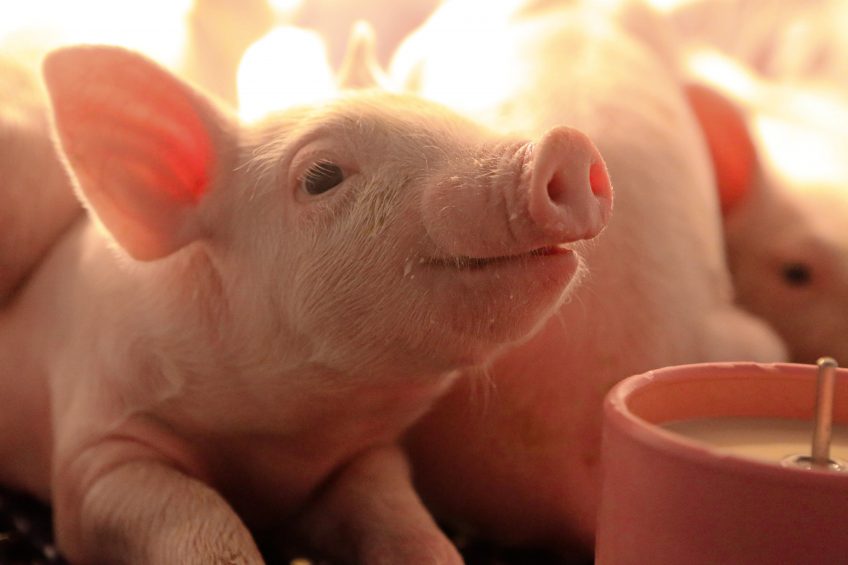Getting piglets off to a good start

It is a well-known phenomenon that the gastro-intestinal tract of piglets is in development. What to feed the animal is important for its further development. Using yeast, it is possible to offer digestible proteins to the younger animals.
Young pigs require good intakes of a highly digestible diet to allow their guts to develop correctly and optimise growth rates. Diets must be formulated to meet the age, body weight and maturity level of the piglet.
The move from milk to a cereal-based diet at weaning can present obstacles that lead to a dip in growth rates, primarily because of poorer nutrient intake. As the gut is still maturing, endogenous enzyme production can be poor and may need supplementation to ensure that feed is well-digested. Ideally, all feed ingredients used in piglet diets must be highly digestible. The use of proven technical products during weaning is beneficial for promoting a balanced gut environment and bacterial microflora because it is highly influenced by the feed substrates flowing to the hindgut. Any poorly digested elements in the diet will be utilised by potentially pathogenic bacteria, leading to diarrhoea and damage to the immature gut wall. Such damage can limit uptake of nutrients, even in a well-digested diet, as the large surface area provided by villi structures can be reduced.
Highly digestible protein
Piglet starter diets typically contain 30 to 60% cereals (which may be cooked or processed to increase digestion), up to 15% soya bean meal and 20% milk products, and, where permitted, fish meal or plasma protein. Ideally, nutrients must be released from intact feed materials in the upper ileum and absorbed in this region, where the concentration of gut villi is maximal, creating a large surface area and providing the most effective uptake.
Using highly digestible protein sources, such as skim milk and whey, can help prevent the flow of undigested protein to the hindgut, which can encourage the growth of toxic E. coli. Protein content should be 18 to 20% in early diets. Typically, fish protein has been used as a digestible source as well, but the ban on these ingredients in many countries – to boost fish stocks – has resulted in the need for alternatives.
Yeast-derived ingredient
NuPro is a yeast-derived ingredient high in digestible protein, inositol, glutamate and gut-active nucleotides, which promote enterocyte cell development and the healing of gut wall damage, especially in young animals. Nucleotides are precursors required for the manufacture of cellular DNA and RNA.
They provide cellular energy in the form of adenosine triphosphate (ATP), act within the cell signalling system, and contribute to glycogen and glycoprotein synthesis. Inositol is involved in nerve function, cell membrane maintenance and repair, the breakdown of fats, and hormone production, all important in the development of the young animal at weaning. This compound is involved in preventing gastric problems during periods of stress, which is commonly seen at weaning.
Glutamate is an amino acid that performs several key functions in piglets. The major provider of energy to the gut tissue, glutamate is also required for various cellular functions, and it is considered essential for intestinal function, especially in immature animals. It also acts as a palatability enhancer; it is added to many human foods for that purpose. In weaned piglets, this is important in promoting the feed intake of nursery/starter diets that are based on cereals.
Compared to sow’s milk, starter pig diets have been shown to be much lower in nucleotides, limiting their availability at weaning when the piglet requires good levels to maintain gut development. Supplementation at this stage is essential to ensure that any damage to the gut because of the change in feed is rectified efficiently and that the intestinal cell lining is suitably developed for nutrient absorption.
Early trials in 2001 established that including the yeast derivative in piglet diets increased feed intake and weight gain. In feeding studies conducted, whereby it was used at levels of 2.5% in the formulation to replace fish meal and whey protein in piglet feeds, there was a 6.5% increase in feed intake and body weights (Table 1). Hence, the yeast derivative supported better piglet performance than diets containing fish meal and whey, and it can be used with confidence as a replacement for fish protein where its use is limited or banned.
Comparison to plasma
The yeast derivative has been compared to plasma, which is regarded as a highly digestible protein source for piglets. Trials conducted in China in 2006 compared a 5% plasma-supplemented diet versus feed supplemented with 2.5% each of the yeast derivative and plasma, or 5% of the yeast derivative alone, see Table 2. In the 38-day study on piglets during pre- and post-weaning, piglets on the combined plasma and yeast diet had a 3% better feed conversion ratio (FCR), whereas piglets on the 5% treatment with only the yeast derivative resulted in a 7% greater FCR compared to piglets on the plasma-only diet.
Economic evaluations showed that the 5% yeast-only feed was more than 1 RMB (€ 0.13) per kg cheaper than the plasma-only feed. In countries where there are concerns about bovine spongiform encephalopathy, or mad cow disease, as it is commonly known, plasma is not allowed to be used in piglet diets because it originates from an animal considered to be a potential disease carrier. The study’s findings confirm that the yeast derivative is a suitable replacement for plasma without losses in piglet performance.
Gut morphology and digestibility
Various trials have investigated the impact of the yeast derivative on gut morphology and digestibility. Back in 2005, researchers studied the effects on the gut and found an increase in daily gain compared to piglets fed a diet formulated with high-quality plasma protein. Including the yeast derivative increased the villi-to-crypt ratio in the gut wall, increasing absorptive surface area, and the gut tissue was better maintained during the weaning process, when it is most at risk from damage from bacterial toxins.
It has also been established that the extra energy that is supplied with the compounds in the yeast derivative, for cellular energy, for example, can replace the need for using any lactose in the feed of young pigs. When in 2007 more than 30 piglet trials using the yeast derivative were compared as part of a meta-analysis review, an average response was found of 4% higher growth rates, 3% better feed conversion and 1% increased feed intake.
The amount of haptoglobin (an acute phase protein) in blood is used as an indicator of physiological stress, a known problem at weaning. When researchers in 2007 investigated the effects of including the yeast derivative in piglet feeds on this parameter, they found a significant reduction in haptoglobin concentration. This demonstrated that feeding the yeast derivative to newly weaned piglets contributes to better health, and healthier piglets have better growth performance and efficiency.
In conclusion
Research in piglet gut development and digestive health has resulted in a robust body of published data regarding the importance of highly digestible protein from sustainable sources, such as NuPro from yeast. In addition, the active compounds in that yeast derivative assist in gut development and maturation in young animals, especially during the stressful time of weaning. Ensuring that piglet diets are formulated with good quality, highly digestible feed materials that contribute to intestinal development and the maintenance of the gut wall is essential for efficient growth. This gives piglets the best chance of optimal productive performance with fewer digestive disorders, especially when transitioning from a milk-based to a cereal-based diet.











